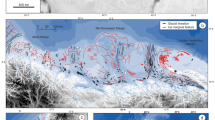Abstract
Oceanic basins are shaped by a variety of natural drivers that impact the seafloor morphology at different scales, spanning from hundreds of kilometres for plate motions to decimetres for bio-constructions by benthic organisms. In the post-industrial period of the oceanic basin history, anthropic activity on the seabed has started to provide an additional morphologic imprint. Because oceanic basins are sinks for sediments produced on land, the majority of the seafloor morphology is produced by forces acting on sediments, resulting in sediment accumulation, transport, erosion and deformation. Plate tectonics forces are reflected dramatically in the morphology of areas of the oceans where the sedimentary cover is thin, or even absent, along the mid ocean ridges, and fracture zones. Chemical reactions in the oceanic subsurface induce mineral precipitation, dissolution or transformation that may also indirectly impact the seafloor.
Similar content being viewed by others
Suggested Reading
Section 2
Cox A, Hart RB (1986) Plate tectonics: how it works. Wiley-Blackwell
Section 3
Sengupta SM (2012) Introduction to sedimentology. CBS Publisher
Section 4
Moscardelli L, Wood L (2007) New classification system for mass transport complexes in offshore Trinidad. Basin Res 201:73–98
Shipp RC, Weimer P, Posamentier HW (2011) Mass-transport deposits in deepwater settings. SEPM Special Publication 96, Tulsa, Oklahoma
Weimer P, Link MH (2013) Seismic facies and sedimentary processes of submarine fans and turbidite systems. Springer Science & Business Media
Section 5
Hambrey MJ, Christoffersen P, Glasser NF et al (2007) Glacial sedimentary processes and products. IAS Special Publication 39, Wiley
Section 6
Judd A, Hovland M (2009) Seabed fluid flow: the impact on geology, biology and the marine environment. Cambridge University Press
Section 7
Rebesco M, Camerlenghi A (2008) Contourites. Development in Sedimentology Series 60, Elsevier, Amsterdam
Section 8
Burdige DJ (2006) Geochemistry of marine sediments. Princeton University Press
Dean WE (2014) Marine evaporites. In: Harff J, Meschede M, Petersen S, Thiede J (eds) Encyclopedia of marine geosciences. Springer, pp 1–10
Fleury P, Bakalowicz M, de Marsily G (2007) Submarine springs and coastal karst aquifers: a review. J Hydrol 339:79–92
Harris PT, Baker EK (2011) Seafloor geomorphology as benthic habitat: GeoHAB atlas of seafloor geomorphic features and benthic habitats, 1st edn. Elsevier
Tivey MK (1991) Hydrothermal vent systems. Oceanus 34:68–74
Section 9
National Research Council (1989) Our seabed frontier: challenges and choices. Report of the committee on existing and potential uses of the seafloor, Division on Engineering and Physical Sciences; Commission on Engineering and Technical Systems. National Academic Press
Author information
Authors and Affiliations
Corresponding author
Editor information
Editors and Affiliations
Rights and permissions
Copyright information
© 2018 Springer International Publishing AG
About this chapter
Cite this chapter
Camerlenghi, A. (2018). Drivers of Seafloor Geomorphic Change. In: Micallef, A., Krastel, S., Savini, A. (eds) Submarine Geomorphology. Springer Geology. Springer, Cham. https://doi.org/10.1007/978-3-319-57852-1_9
Download citation
DOI: https://doi.org/10.1007/978-3-319-57852-1_9
Published:
Publisher Name: Springer, Cham
Print ISBN: 978-3-319-57851-4
Online ISBN: 978-3-319-57852-1
eBook Packages: Earth and Environmental ScienceEarth and Environmental Science (R0)




